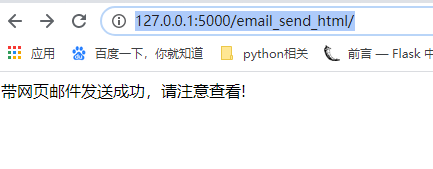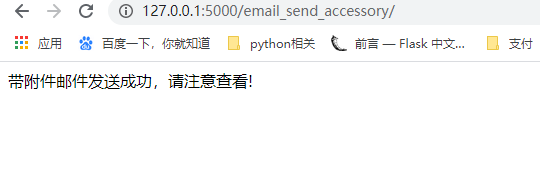Flask学习之 flask-mail邮件
一.安装相关依赖
在具有flask框架下的环境下安装相关依赖库:
pip install flask-mail
二.配置文件
在配置文件config.py中添加配置常量,下面的example修改为自己的邮箱
1.163的配置
# 邮件服务器地址 这边使用163,也可以使用qq:smtp.qq.com MAIL_SERVER = 'smtp.163.com' # 邮件服务器端口 # 163 邮件 TLS对应465/994 SSL使用 25 端口 MAIL_PORT = 25 # True 为开启SSL # EMAIL_USE_SSL = True # MAIL_USE_SSL : 默认为 False MAIL_USE_TLS = False # 启用 TLS # 发件人的163邮箱地址 MAIL_USERNAME = "example@163.com" # 163授权码 MAIL_PASSWORD = "YVLYCBDQACSPGTXM"
2.qq的配置
MAIL_SERVER = 'smtp.qq.com' # 邮件服务器端口 # qq邮件 TLS对应端口465或587 MAIL_PORT = 465 # True 为开启SSL MAIL_USE_SSL = True # MAIL_USE_SSL : 默认为 False MAIL_USE_TLS = False # 启用 TLS # 发件人的qq邮箱地址 MAIL_USERNAME = "example@qq.com" # qq授权码 MAIL_PASSWORD = "xsohghbumdyhggeg" #"emca advo kbhu gjhg"
三.发送邮件的demo
1.邮件发送的三个例子接口代码
from flask import Flask, render_template from flask_mail import Mail, Message import config import os mail = Mail() app = Flask(__name__) app.config.from_object(config) mail.init_app(app) # 1.发送文本 @app.route('/send_mail/') def email_send_charactor(): """ subject 为邮件标题 recipients 为接收邮件账号 body 为邮箱内容 :return: """ message = Message(subject='hello flask-mail', sender=app.config['MAIL_USERNAME'], recipients=['接收人邮件地址'], body='flask-mail邮件内容') mail.send(message) try: mail.send(message) return '邮件发送成功,请注意查看!' except Exception as e: print(e) return '邮件发送失败' # 2.发送一个html @app.route('/email_send_html/') def email_send_html(): """ email_demo.html 为发送邮件时候所带的网页 :return: """ message = Message(subject='flask-mail html', sender=app.config['MAIL_USERNAME'], recipients=['接收人邮件地址']) try: # 发送渲染一个模板 message.html = render_template('email_demo.html') mail.send(message) return '带网页邮件发送成功,请注意查看!' except Exception as e: print(e) return '邮件发送失败' # path = os.path.dirname(__file__) # filename = os.path.join(path, 'Chopper.jpg') # 3.发送邮件带附件 @app.route('/email_send_accessory/') def email_send_accessory(): """ Chopper.jpg 为附件名 :return: """ message = Message(subject='flask-mail accessory', sender=app.config['MAIL_USERNAME'], recipients=['接收人邮件地址'], body='添加了一个附件') try: # 发送一个附件的文件 with open("Chopper.jpg", 'rb') as fp: # message.attach(filename, "image/jpg", fp.read()) message.attach("Chopper.jpg", "image/jpg", fp.read()) mail.send(message) return '带附件邮件发送成功,请注意查看!' except Exception as e: print(e) return '邮件发送失败' if __name__ == '__main__': app.run(debug=True) # host='0.0.0.0',debug=True,port=6000
2.相应的文件目录结构如下

3.访问接口发送邮件
(1)普通的邮件
访问:http://127.0.0.1:5000/send_mail/

(2)带网页的邮件
访问:http://127.0.0.1:5000/email_send_html/

(3)带附件的邮件
访问:http://127.0.0.1:5000/email_send_accessory/

4.异步发送邮件demo
使用的配置文件还是config.py
from flask import Flask, render_template from flask_mail import Mail, Message import config import os mail = Mail() app = Flask(__name__) app.config.from_object(config) mail.init_app(app) # 4.异步发送邮件 from threading import Thread @app.route('/send_async_email/') def index(): res = send_mail() return '异步邮件发送成功,请注意查看!' def send_async_email(app, msg): with app.app_context(): mail.send(msg) def send_mail(): # sender-发件人邮箱 recipients-收件人邮箱 msg = Message("flask-mail async", sender=app.config['MAIL_USERNAME'], recipients=['1391053697@qq.com']) msg.body = "这个是一个异步邮件" # Flask支持很多,比如附件和抄送等功能,根据需要自己添加就可以 # msg.attach 邮件附件添加 # msg.attach("文件名", "类型", 读取文件) # with app.open_resource("test.jpg") as fp: # msg.attach("image.jpg", "image/jpg", fp.read()) thr = Thread(target=send_async_email, args=[app, msg]) # 创建线程 thr.start() print(thr,"线程。。。。。。。。。。。") return thr if __name__ == '__main__': app.run(debug=True) # host='0.0.0.0',debug=True,port=6000
访问:http://127.0.0.1:5000/send_async_email/



